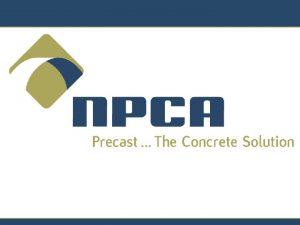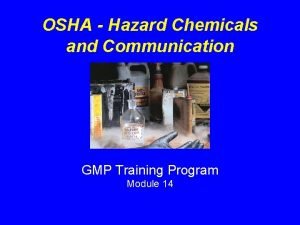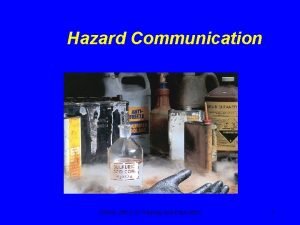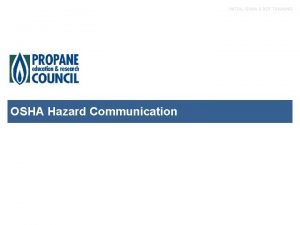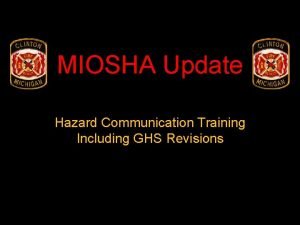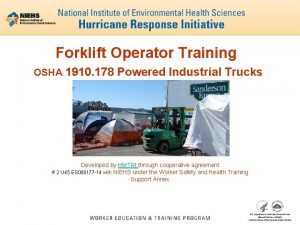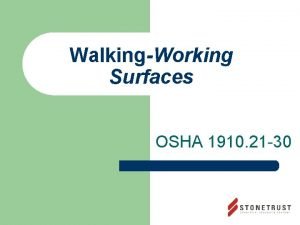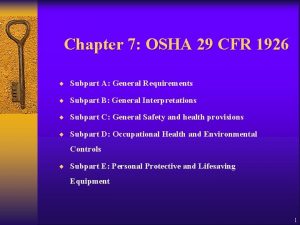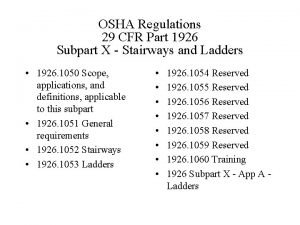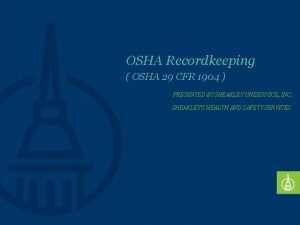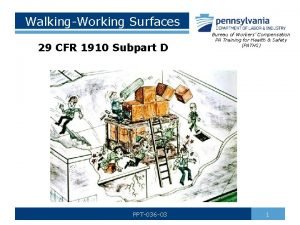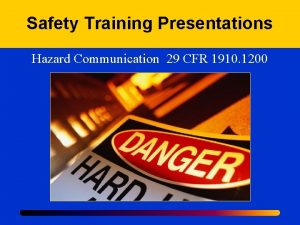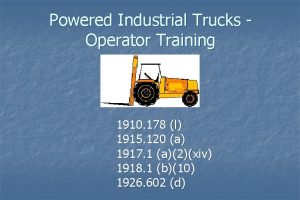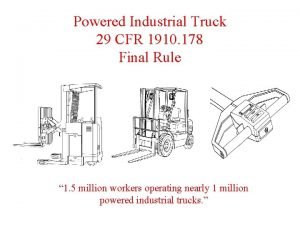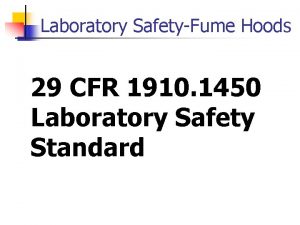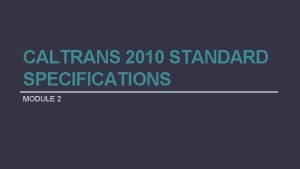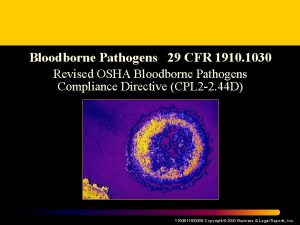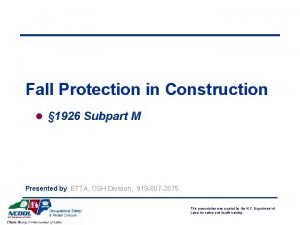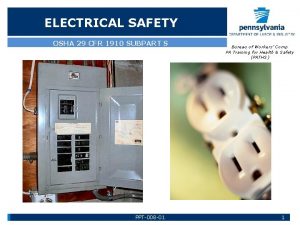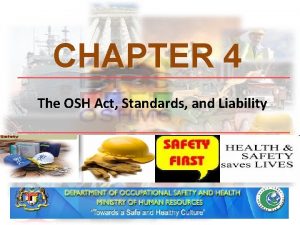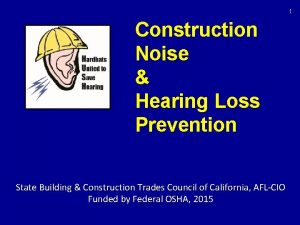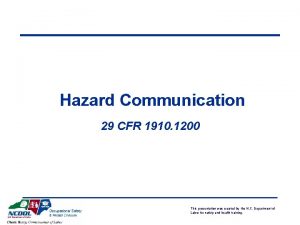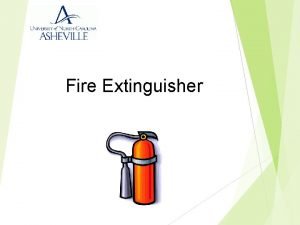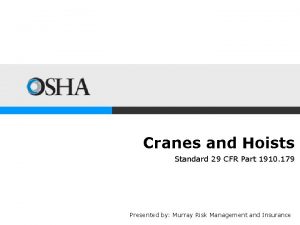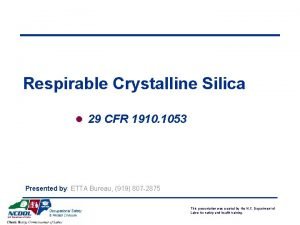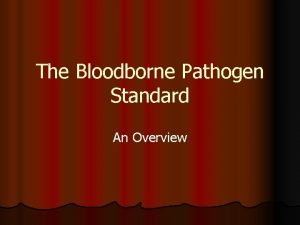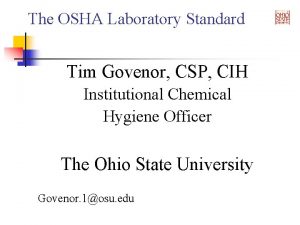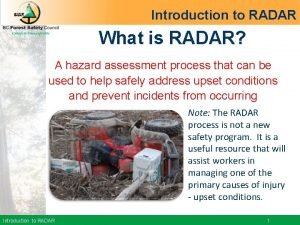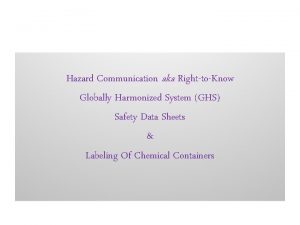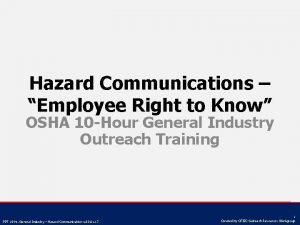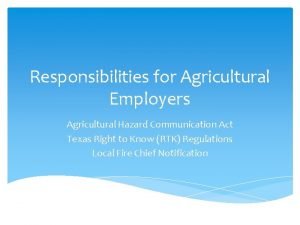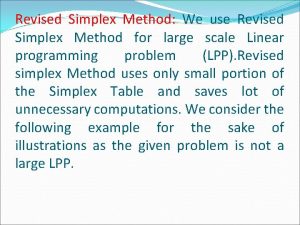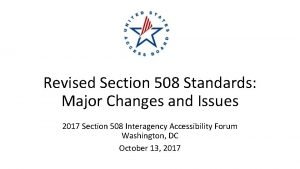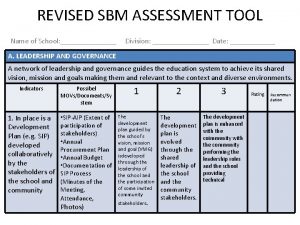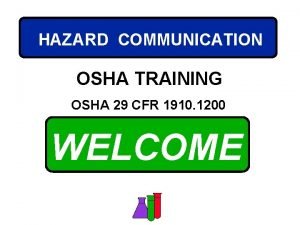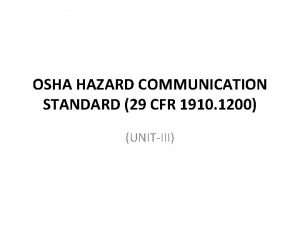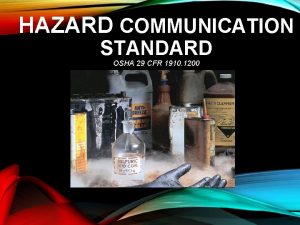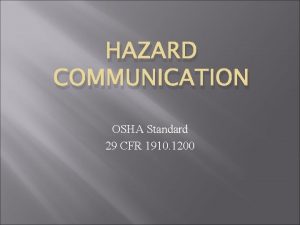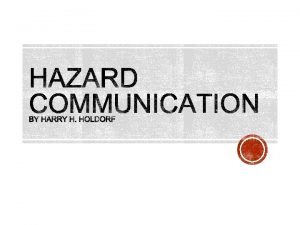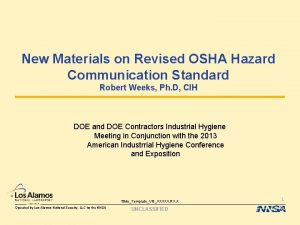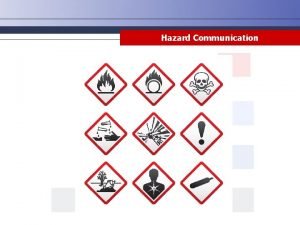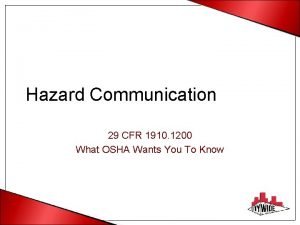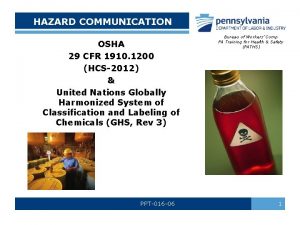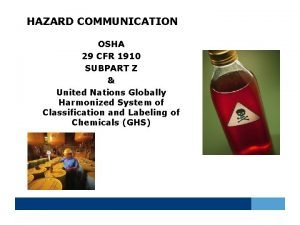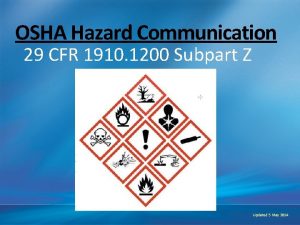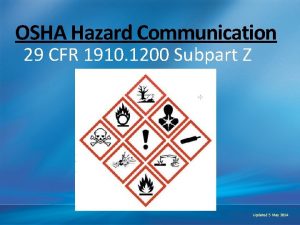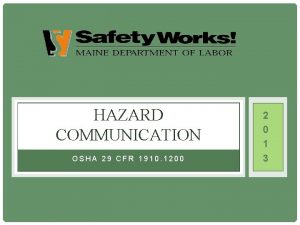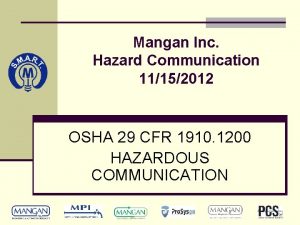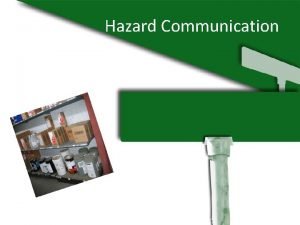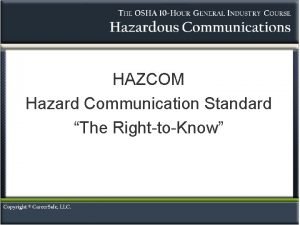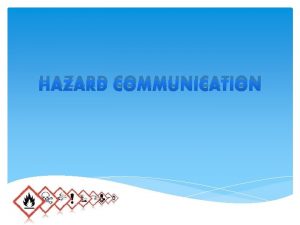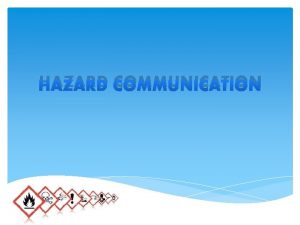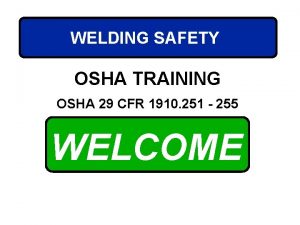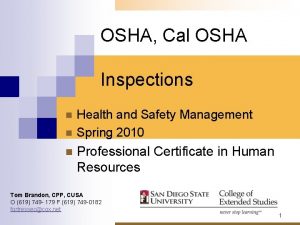PMAA OSHA REVISED HAZARD COMMUNICATION STANDARD 29 CFR













































- Slides: 45

PMAA OSHA REVISED HAZARD COMMUNICATION STANDARD 29 CFR 1910. 1200

HAZCOM OVERVIEW • Compliance with OSHA hazardous communication standard (HCS) has been required since 1983. • OSHA recently revised the HCS requirements to harmonize with international standards. • HCS provides employees the right-to-know the hazards and identities of the chemicals they are exposed to in the workplace. • Employers must disclose to empl 0 yees information about the presence and nature of hazardous chemicals in workplace through access to container warning labels, safety data sheets and written HAZCOM plan. • Employers must train employees how to recognize and understand OSHA chemical hazard information.

HAZCOM OVERVIEW • Petroleum manufacturers (refiners, terminal operators) must provide petroleum distributors new safety data sheets (SDS) for hazardous chemicals (petroleum products)to replace current material safety data sheets (MSDS). • Petroleum distributors must provide new SDS to retailers. • Petroleum distributors and retailers are “employers” and must provide employees with access to SDS and have a written HCS program. • Petroleum distributors and retailers must train employees how to recognize and understand information on hazardous chemical labels and SDS. • Petroleum distributors and retailers must label all hazardous chemical containers (including stationary ASTs and skid tanks) with new OSHA HCS labels. • Petroleum retailers must provide SDS to customers upon request only.

WHY THE CHANGES? OSHA changed the workplace hazard communication standard to align with international standards. Globally Harmonized System of Classification and Labeling of Chemicals (GHS) adopted by 67 nations.

WHICH HCS REQUIREMENTS ARE CHANGING? • Material Safety Data Sheet name and format. Ø 16 new hazard information sections. • Chemical container label information and format. Ø New pictograms. Ø Signal words. Ø Hazard statements. Ø Precautionary statements. Ø Product information. Ø Suppler/manufacturer identification.

WHO MUST COMPLY? • Chemical Manufacturers, Importers Ø Change SDS format. Ø Change Container label format. • Petroleum Distributors: Ø Must pass down new SDS to all customers who are employers on first delivery. • Petroleum Distributors and Retailers: Ø Must train employees on new SDS sheets and container labels.

WHO MUST BE TRAINED? • Only employees working in areas where hazardous chemicals are present must be trained. Ø Work area means a room or defined space in a workplace where hazardous chemicals are produced or used, and where employees are present. Ø Workplace means an establishment, job site, or project, at one geographical location containing one or more work areas. Ø Employees just passing through but not assigned to the work area need not be trained.

WHO MUST BE TRAINED? • Anyone working directly in the presence of hazardous chemicals in the workplace that pose a risk for the employee’s health and/or environmental hazard. (very subjective). ØDrivers at loading racks. ØLube 0 il warehouse. ØCar wash employees. ØC-store employees. ØHVAC Service technicians.

WHAT KIND OF TRAINING? • Training must be such that employees: Ø Recognize and understand hazards of chemical based on information in the 16 new sections of the SDS format. Ø Recognize and understand pictograms, precautionary statements, signal words, hazard statements, product identification and identity of manufacturer on container shipping label.

WHEN IS TRAINING REQUIRED? • Upon initial employment. • When a new hazardous product/chemical is introduced into the workplace. • Change in process. • As deemed necessary by supervisor/management.

COMPLIANCE DATES Ø Both petroleum marketer distributors and retailers must update their written hazard communication program, workplace container labeling (skid tanks and stationary above ground bulk tanks included), train employees concerning the OSHA HCS revisions (labels and SDS) no later than June 1, 2016. Ø Petroleum marketer distributors should supply retailers with new SDS as soon as they become available from upstream suppliers but no later than June 1, 2016. Chemical manufacturers were required to provide the new SDS to downstream distributors by June 1, 2015.

NEW CONTAINER LABELS Ø Container means any bag, barrel, bottle, box, can, cylinder, drum, storage tank, or the like that contains a hazardous chemical. Ø Portable skid tanks and stationary above ground storage tanks must be labeled. Ø Cargo tank vehicles are not required to have OSHA labels. Ø Fuel tanks or other operating systems in a vehicle do not need to be labeled in accordance with this standard as they are not considered containers. Ø Liquid propane (LP) cylinders for delivery must be labeled.

NEW CONTAINER LABEL ELEMENTS 9 new Symbols called “pictograms”. Signal Words. Hazard Statements. Precautionary Statements. Product Identification. Supplier/Manufacturer Identification. Supplementary Information.

LABEL PICTOGRAMS • There are 9 pictograms in three hazard categories: Ø Health Hazards. ØPhysical Hazards. ØEnvironmental Hazards.

LABELS: PICTOGRAMS – HEALTH HAZARDS Describes: Acute toxicity (Severe) Describes: Acute toxicity (Less Severe): Irritant Dermal sensitizer Acute toxicity (harmful) Narcotic effects Respiratory tract irritation

LABELS: PICTOGRAMS – HEALTH HAZARDS Skin corrosion Serious eye damage/ Eye irritation Carcinogen Respiratory sensitizer Reproductive toxicity Target organ toxicity Mutagenicity Aspiration Hazard

LABELS: PICTOGAMS -PHYSICAL HAZARDS Explosives Self reactives Organic peroxides Flammables Self reactives Pyrophorics Self heating Emits flammable gas Organic peroxides

LABELS: PICTOGRAMS – PHYSICAL HAZARDS Corrosive to Metals Oxidizer Gases under Pressure

LABELS: PICTOGRAM - ENVIRONMENTAL HAZARD Environmental Hazard

U. S. DOT SHIPPING LABELS PICTOGRAMS MAY BE USED Flammable Liquid Flammable Gas Flammable Aerosol Flammable solid Self-Reactive Substances Pyrophorics (Spontaneously Combustible) Self-Heating Substances, which in contact with water, emit flammable gases (Dangerous When Wet) Oxidizing Gases Oxidizing Liquids Oxidizing Solids Explosive Division 1. 4 Explosive Division 1. 5 Explosive Division 1. 6 Compressed Gases Acute Toxicity (Poison): Oral, Dermal, Inhalation Corrosive Marine Pollutant Explosive Divisions 1. 1, 1. 2, 1. 3 Organic Peroxides

LABEL SIGNAL WORDS • Only two signal words are used to indicate the severity of the hazard and alert employees to the potential hazard. Ø “DANGER” more severe hazard). Ø“WARNING” (less severe hazard). • Not all labels will have a signal word. Some chemicals are not hazardous enough to require that a signal word appear on the label.

LABEL -HAZARD STATEMENT There are specific hazard statements that must appear on the label based on the chemical hazard classification. Examples: Ø Flammable liquid and vapor. Ø Causes skin irritation. Ø May cause cancer.

LABEL – PRECAUTIONARY STATEMENT • Recommended measures related to: Ø Prevention. Ø Response. Ø Storage. Ø Disposal. • Examples: ØWear respiratory protection. ØWash with soap and water. ØStore in a well ventilated place. ØNot a mandate for employers/employees to follow.

LABEL – PRODUCT IDENTIFICATION • Product identification (i. e. name OR number the of product).

LABEL - MFG/SUPPLIER IDENTIFICATION • The following manufacturer and/or supplier identification must be on label: Ø Address. Ø Telephone number. Ø Use batch label , name address and phone number for multiple manufacturers.

LABEL – OTHER INFORMATION • Other information that may be included on the label at the discretion of manufacturer or distributor: Ø Ø Ø Ø Physical state. Color. Hazards not otherwise classified. Route of exposure. Storage and disposal. Hazard prevention and, Emergency response instructions.


ALTERNATIVE CONTAINER LABELS • Repackaging hazardous chemicals. Employers must label repackaged containers with either: Ø GHS Label; or Ø Alternative label that: • Is consistent with the revised HAZCOM standard. • Does not have conflicting hazard warnings or pictograms. Example: NFPA Label must include OSHA notation of chronic health effects. NFPA does not allow altering the white diamond within the larger diamond.

SAFETY DATA SHEETS • What’s New? ØName –Now called “Safety Data Sheet” (SDS). ØFormat -All SDSs will have a consistent 16 -section format. Safety Material Data Safety Sheets Data Sheets

NEW 16 SECTION SDS FORMAT Section 1 – Identification Section 2 – Hazard(s) identification Section 10 – Stability and Reactivity Section 11 – Toxicological Information Section 3 – Composition / Information on Ingredients Section 12 – Ecological Information Section 4 – First-aid Measures Section 5 – Fire-fighting Measures Section 6 – Accidental Release Measures Section 7 – Handling and Storage Section 8 – Exposure Controls / Personal Protection Section 9 – Physical and Chemical Properties Section 13 – Disposal Consideration Section 14 – Transport Information Section 15 – Regulatory Information Section 16 – Other information including date of preparation of last revision

SDS FORMAT SECTIONS Section 1 – Identification: Identifies the chemical on the SDS as well as the recommended uses. It also provides the essential contact information of the supplier. Section 2 - Hazards Identification: Hazards of the chemical presented on the SDS Appropriate warning information associated with those hazards.

SDS FORMAT SECTIONS Section 3 – Composition / Ingredients: Identifies the ingredient(s) contained in the product indicated on the SDS, including: • • Impurities and stabilizing additives. Information on substances, mixtures, and all chemicals where a trade secret is claimed. Section 4 - First-Aid Measures: Describes the initial care that should be given by untrained responders to an individual who has been exposed to the chemical.

SDS FORMAT SECTIONS Section 5 – Fire-Fighting Measures: Provides recommendations for fighting a fire caused by the chemical. Section 6 - Accidental Release Measures: Provides recommendations for appropriate response to spills, leaks, or releases, (e. g. containment and cleanup practices).

SDS FORMAT SECTIONS Section 7 – Handling and Storage: Provides guidance on the safe handling practices and conditions for safe storage of chemicals. Section 8 – Exposure Controls / Personal Protection: Indicates the exposure limits, engineering controls, and personal protective measures that can be used to minimize worker exposure.

SDS FORMAT SECTIONS Section 9 – Physical and Chemical Properties: Identifies physical and chemical properties associated with the substance or mixture. Section 10 – Stability and Reactivity: Describes the reactivity hazards of the chemical and the chemical stability information.

SDS FORMAT SECTION Section 11 - Toxicological Information: Identifies toxicological and health effects information or indicates is data unavailable. Section 12 – Ecological Information Identifies release pathways and subsequent environmental harm. Section 13 – Disposal Consideration Identifies proper method of disposal.

SDS FORMAT SECTION Section 14 – Transport Information Identifies U. S. DOT hazard description. Section 15 – Regulatory Information Federal law citation that regulates the hazardous chemical. Section 16 – Other Information Indicates when the SDS was prepared or when the last known revision was made. The SDS may also state where the changes have been made to the previous version.

SAMPLE SAFET DATA SHEETS WARNING! THE FOLLOWING SAFETY DATA SHEET SAMPLES ARE FOR ILLUSTRATION ONLY. DO NOT REUSE. SDS WILL VARY BETWEEN BRAND SUPPLIER.





EMPLOYEE ACCESS • SDSs, safety labels and written HAZCOM plan: • Must be readily accessible to employees during their work shift. • Are typically kept in a centralized location. • Must be updated as new information becomes available. • Computerized files are ok so long as employee has access.

WRITTEN HAZARD COMMUNICATION PLANS • The HCS requires all workplaces where employees are exposed to hazardous chemicals to have a written plan. • A written hazard communication plan describes how the facility will implement the revised HCS standard. • The plan does not have to be lengthy or complicated. It is intended to be a blueprint for implementing your program -- an assurance that all aspects of the requirements have been addressed. • The written program must describe how the requirements for labels and other forms of warning, materials safety data sheets, and employee information and training, are being met. • A written hazard communication template is attached.

BOTTOM LINE • Both petroleum marketers and petroleum retailers must: Ø Train employees on how to recognize and understand new HCS labels and safety data sheets. Ø Provide access to HCS information including SDS, labels in a central HCS file. Ø Revise existing OSHA written hazardous communication program. Ø Affix new revised OSHA HCS labels on workplace containers of hazardous chemicals including stationary above ground storage tanks and skid tanks. • Petroleum Distributors must provide retailers and other customers who are employers a copy of new SDS for each petroleum product delivered on first delivery and when SDS changes
 Osha 29cfr1910.134
Osha 29cfr1910.134 29 cfr 1910 hazard communication
29 cfr 1910 hazard communication Osha hazard and ghs training regulation cfr 1910
Osha hazard and ghs training regulation cfr 1910 Osha cfr 1910 is the standard for______.
Osha cfr 1910 is the standard for______. Osha hazard communication inital training
Osha hazard communication inital training Miosha hazard communication standard
Miosha hazard communication standard 29 cfr 1910 powered industrial trucks
29 cfr 1910 powered industrial trucks 29 cfr 1910 powered industrial trucks
29 cfr 1910 powered industrial trucks Osha housekeeping standard 1910
Osha housekeeping standard 1910 1910 subpart h
1910 subpart h 1926 subpart c
1926 subpart c Osha handrail requirements 1926
Osha handrail requirements 1926 1904 recordkeeping
1904 recordkeeping Osha 1910 subpart d
Osha 1910 subpart d 29 cfr 1910
29 cfr 1910 29 cfr 1910 osha 178
29 cfr 1910 osha 178 29cfr1910.178
29cfr1910.178 29 cfr 1910 osha 178
29 cfr 1910 osha 178 Caltrans revised standard specifications
Caltrans revised standard specifications Bloodborne pathogens quiz answers
Bloodborne pathogens quiz answers Osha hot work standard
Osha hot work standard 29 cfr 1926 subpart m
29 cfr 1926 subpart m Osha 1910 subpart s
Osha 1910 subpart s The osha ionizing radiation standard applies
The osha ionizing radiation standard applies Osha noise level standards
Osha noise level standards Osha 1910 psm standard
Osha 1910 psm standard Osha portable fire extinguisher quiz
Osha portable fire extinguisher quiz Osha 1910 crane standard
Osha 1910 crane standard Osha silica standard 1910
Osha silica standard 1910 Osha's bloodborne pathogens standard covers
Osha's bloodborne pathogens standard covers Osha laboratory standard 1910
Osha laboratory standard 1910 Hazard communication quiz answers
Hazard communication quiz answers Hazard communication quiz answers
Hazard communication quiz answers Hazard communication ppt
Hazard communication ppt Texas hazard communication act
Texas hazard communication act Std error
Std error Standard language examples
Standard language examples Standard costs are
Standard costs are Peruntukan masa kssm
Peruntukan masa kssm Bp form 202
Bp form 202 Maureen neihart keynote revised profiles of the gifted
Maureen neihart keynote revised profiles of the gifted Revised primary curriculum grade 1-3
Revised primary curriculum grade 1-3 Simplex method
Simplex method Revised section 508 standards
Revised section 508 standards Accountability assessment criteria and tools
Accountability assessment criteria and tools Fiscal incentives for industrial promotion (revised)-2013
Fiscal incentives for industrial promotion (revised)-2013

